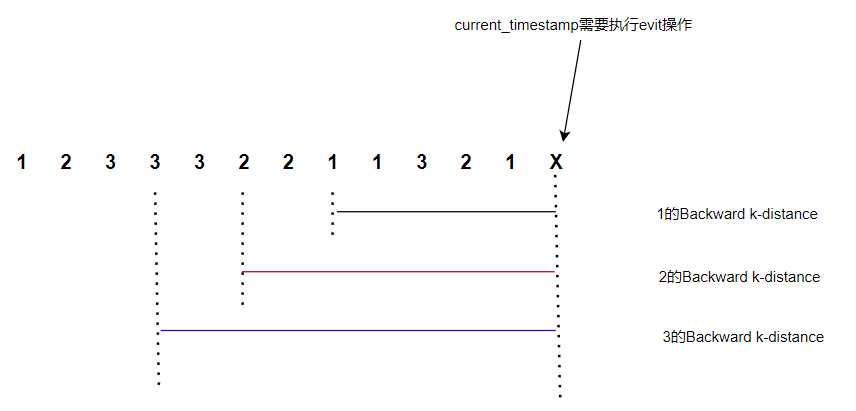

CMU445-Project1-LRU-K 总结
source link: https://greenhathg.github.io/2023/06/06/CMU445-Project1-LRU-K%E6%80%BB%E7%BB%93/
Go to the source link to view the article. You can view the picture content, updated content and better typesetting reading experience. If the link is broken, please click the button below to view the snapshot at that time.

https://15445.courses.cs.cmu.edu/fall2022/project1/
DB 的 Buffer Replacement Policies 中的 LRU 和 Clock 算法都容易受到 sequential flooding 的影响,对于 LRU 来讲,使用 LRU-K 算法能够缓解这个问题。
LRU-K
- This component is responsible for tracking page usage in the buffer pool.
- The LRU-K algorithm evicts a frame whose backward k-distance is maximum of all frames in the replacer.
- Backward k-distance is computed as the difference in time between current timestamp and the timestamp of kth previous access.
- A frame with less than k historical accesses is given +inf as its backward k-distance.
- When multipe frames have +inf backward k-distance, the replacer evicts the frame with the earliest timestamp.
Backward k-distance
这个数据很关键,也很容易被理解错,下面举例说明,当 k=3 时候
由上面的定义可知,Backward k-distance 为 current_timestamp 和倒数第 k 次访问的时间之差,故 k=3 时候如上面所示
因为每次 current_timestamp 都是一样的,所以其实直接看第 k 次访问的时间点就好,这里可以不用记下每次访问的时间戳,直接记录访问对应的 index 就好了,也就说记住某个数在第几次出现就好了。
每次都选择最大的 Backward k-distance 驱除 (evit),这里存在两种情况:
某个数已经有了 k 次访问记录,那么 Backward k-distance 就是上图所示
如果不够 k 次访问,那么 Backward k-distance 就是正无穷大
那么每次 evit 时候肯定都是优先选择第二种情况,因为是正无穷大
- 如果有多个无穷大,则按照 FIFO 的顺序 evit
比如访问顺序如下(从左到右依次访问),假设 k=31 2 3 4 1 2 3 1 2
这里无限大的数有 3 和 4,按照 FIFO 顺序,3 第一次出现的时间点和 4 还早,所以第一次 evit 时候选择 3
- 如果有多个无穷大,则按照 FIFO 的顺序 evit
- 第二种情况没有了的话,则按照第一种情况,这里直接看哪个数倒数第 k 次最早出现就好了,那么就是 Backward k-distance 最大的
SetEvictable
需要注意的是某个数是 evitable 才能被 evit,也就是 ` 这个函数的作用,因为此时某个数据正在被访问,不能 evit
有一种情况是 SetEvictable 时候,但是这个数还没有被访问过或者是被 evit 了,那么这个函数直接 return 就好了
Implementation
我是使用了两个顺序容器和一个 map
map 记录了某个数第 n 次访问的 index,比如 hist (1, 3),代表 1 这个数第 3 次访问的 index
当某个数还没有访问 k 次时候,就放到第一个容器,保证容器内的顺序是 FIFO 的,这样每次从队首或者队尾出队就好了,因为某些数可能不是 Evictable 的,实际上需要遍历一下容器,找到第一个能够 Evictable 的。
如果达到 k 次,那么把这个数从第一个容器挪到第二个容器
evit 时候,如果第一个容器已经是 empty 的,那么代表没有正无穷的数,需要从第二个容器拿,此时因为 map 记录了每次容器出现的时间点,按照 map 对容器排序后直接取好了。这里没有想到一个方法类似第一个容器那么维护状态,考虑一下访问顺序:
1 1 1 2 2 2 1 X虽然 1 是最后 evit 的,但是按照 Backward 3-distance 来看,1 才是要 evit,不能每次访问就更新那个数在第二个容器的位置。
看了下 discord 的讨论,有比这个更快的方法,应该使用了堆之类的容器维护
维护某个数是否已经出现,以及其状态:
struct LruEntry {
bool evictable_{false};
size_t access_count_{0};
};
std::unordered_map<frame_id_t, LruEntry> lru_entry_hash_;
第一个容器:
std::list<frame_id_t> less_than_k_frames_;
第二个容器:
std::vector<frame_id_t> more_than_k_frames_;
记录每个数每次出现的时间点:
struct PairHash {
auto operator()(const std::pair<frame_id_t, size_t> &p) const -> std::size_t {
// 使用 std::hash 计算哈希值
std::size_t h1 = std::hash<frame_id_t>{}(p.first);
std::size_t h2 = std::hash<size_t>{}(p.second);
return h1 ^ (h2 << 1); // 可以使用异或和位移等运算来组合哈希值
}
};
std::unordered_map<std::pair<frame_id_t, size_t>, size_t, PairHash> hist_;
获取某个数第 k 次出现的时间:
auto GetLastKAccessTime(const frame_id_t x) const -> size_t {
const auto last_k = lru_entry_hash_.at(x).access_count_ - k_ + 1;
return hist_.at(std::make_pair(x, last_k));
}
按照 Backward k-distance 对第二个容器排序:
std::sort(more_than_k_frames_.begin(), more_than_k_frames_.end(),
[&](frame_id_t a, frame_id_t b) { return GetLastKAccessTime(a) < GetLastKAccessTime(b); });
Recommend
About Joyk
Aggregate valuable and interesting links.
Joyk means Joy of geeK
